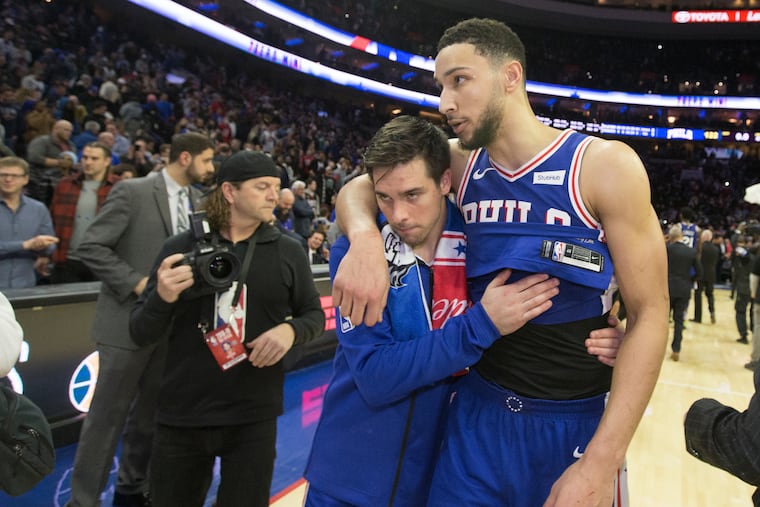Sixers still a team in flux, but they are finding ways to make do | David Murphy
In a lot of ways, we do not know who the Sixers are. Or, more specifically, we do not know what they will eventually become.

There’s something bedeviling about this Sixers team. The NBA season is 60 percent complete, and it has gone about as well as anybody could have hoped. After a skin-of-their-teeth win over the Spurs on Wednesday night, the Sixers are on pace for 53 wins, one more than last season, and are 3 1/2 games behind the No. 1 seed in the Eastern Conference.
They are scoring more points (113 per 100 possessions, up from 109.5 last season), they have an MVP candidate at center (against the Spurs, Joel Embiid scored 30-plus points for the fourth time in five games), and they have won three of the first four games of a 12-game stretch that features a gauntlet of some of the NBA’s most legitimate contenders.
Yet, in a lot of ways, we do not know who they are. Or, more specifically, we do not know what they will become.
The poster boy for this phenomenon is a guy who coach Brett Brown pointed to Wednesday night as a decisive factor in his team’s win over the Spurs. Wilson Chandler’s final stat line was hardly a case for enshrinement — 6 points, a couple of assists, a couple of rebounds — but he hit a couple of big threes and played 36 minutes on a night when Jimmy Butler was sidelined with a wrist injury.
Most significantly, Chandler spent much of the night matching up on the defensive end of the court with a small Spurs lineup that tried to exploit his presence. San Antonio is a devil of a team, and Gregg Popovich is a devil of a coach. Of the seven Spurs who finished with 20-plus minutes, five were guards or wings, four of whom enjoyed a substantial advantage in lateral quickness over the 6-foot-9, 225-pound Chandler.
Chandler was not alone in this disadvantage. The Spurs game plan was clear at all five positions, and the final box score showed its wisdom: seven scorers with 13-plus points, 23 unassisted buckets, a combined 57.3 shooting percentage from the field.
That the Sixers managed to rally to win was attributable to a number of factors, from Embiid’s 33 points and 19 rebounds to the 9-for-18 that JJ Redick and Landry Shamet combined to shoot from three-point range. Mostly, though, it was a testament to their ability to make do.
It’s a quality that Chandler has exemplified more than any other player on the team this season. When the Sixers acquired him from the Nuggets in the offseason, they envisioned a player who could come off the bench and get them buckets. On the defensive end of the court, with Ben Simmons and Robert Covington, and Markelle Fultz in front of him in the rotation, he would be a switchable second-unit wing capable of tilting matchups in their favor.
That plan has rarely been the case. By the time Chandler recovered from a training-camp hamstring injury, Fultz and Covington were gone, along with four-man Dario Saric. While Jimmy Butler filled one of those spots, it effectively fell to Chandler to fill the other two.
At first, that meant stepping into the starting lineup and playing the role of a small-ball four. Lately, though, Brown has increasingly relied upon him at the wing.
“I think it’s the hardest transition for players,” Brown said. “Threes and twos, twos and threes, same same. Fours and fives, fives and fours, kind of same same. When you jump the fence and you go from bigs to wings, often times the structure is very different, and it’s tormenting at times when you have to drown yourself thinking. That’s not how you want to have to play basketball.”
After the win against the Spurs, Chandler gave a nod to this reality. In some ways, he has been better than expected, at least on the offensive end of the court. The 6.6 points per game that he is averaging are the lowest of his career, but that is not necessarily a bad thing.
On a per-shot basis, he is playing with more efficiency than at any other point in his career, shooting .387 from three-point range (career average: .343), with a .544 effective field-goal percentage (career: .496). Yet, he is still in the process of discovering the exact nature of his role.
“It’s been an adjustment," the 31-year-old veteran said. "Everything has been an adjustment thus far. So, I’m just trying to stick it out and keep playing and learn on the run.”
The Spurs game was a prime opportunity for a 48-minute thought experiment. Throughout the contest, you saw the vulnerabilities that the Sixers offer an elite coach to exploit. There was a stretch when you saw the Spurs' Derrick White giving up 6 inches of height and tremendous length to Simmons, a matchup he was unable to take advantage of as thoroughly as when Simmons had the advantage in quickness over Rudy Gay.
Perhaps that would have been different had the Sixers been able to pair him with a guard with the shot-and-handle combination possessed by White, Bryn Forbes, and Patty Mills.
The addition of that sort of player — in particular, a Forbes or a White on the wing — would also take some of the pressure off Chandler on the defensive end of the court. Factor in the return of Butler, and suddenly the Sixers are a more complete puzzle.
As it stands, they are a team both on the rise and in the waiting room. Until the roster is complete, they are fortunate to be able to fall back on the get-'er-done mentalities of veterans such as Chandler and Redick.